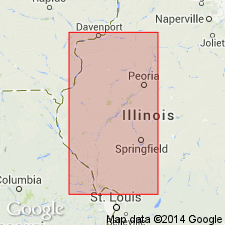
- Usage in publication:
-
- Seahorne limestone
- Modifications:
-
- Original reference
- Dominant lithology:
-
- Limestone
- AAPG geologic province:
-
- Illinois basin
Summary:
Pg. 801-812; Illinois Geol. Survey Bull., no. 60, 1931, p. 179-193. Seahorne limestone. Name applied to a limestone, 0 to 10+/- feet thick, in upper part of Pottsville formation (Pennsylvanian) of central western Illinois. Shown as lying 30+/- feet higher than his Bernadotte sandstone and 100+/- feet higher than coal No. 1, and to contain a distinctive fauna.
[Origin of name not stated.]
Source: US geologic names lexicon (USGS Bull. 896, p. 1946).
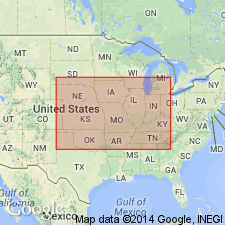
- Usage in publication:
-
- Seahorne limestone
- Modifications:
-
- Areal extent
- AAPG geologic province:
-
- Iowa shelf
Summary:
Chart 6 (column 31). Seahorne limestone. Pennsylvanian correlation chart shows Seahorne limestone in Cherokee group in Iowa. [Age is Pennsylvanian.]
Source: US geologic names lexicon (USGS Bull. 1200, p. 3508).
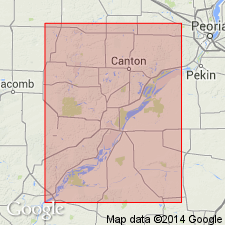
- Usage in publication:
-
- Seahorne limestone
- Modifications:
-
- Revised
- AAPG geologic province:
-
- Illinois basin
Summary:
Pg. 50 (fig. 22), 78-79, geol. sections 5-7, 23, 28-32, 34, 36, 37, 39, 40, 42. Seahorne limestone of Tradewater group. Grades from scattered limonite-stained nodules in clay about 4 inches thick to a solid ledge more than 6 feet thick. Included in Seahorne cyclothem, Tradewater group. [Age is Pennsylvanian.]
Source: US geologic names lexicon (USGS Bull. 1200, p. 3508).
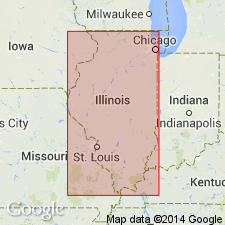
- Usage in publication:
-
- Seahorne limestone member
- Modifications:
-
- Principal reference
- Revised
- AAPG geologic province:
-
- Illinois basin
Summary:
Pg. 33, 46 (table 1), pl. 1. Seahorne limestone member of Spoon formation (new) of Kewanee group (new). Rank reduced to member status in Spoon formation. In southwestern area, occurs above Vergennes sandstone member and below Davis coal member; western area, occurs above DeLong coal member and below Wiley coal member. Age is Pennsylvanian. Presentation of new rock-stratigraphic classification of Pennsylvanian of Illinois. Cyclical classification is retained but is entirely independent of rock-stratigraphic classification.
Type locality: along Seahorne Branch, in S/2 SE/4 sec. 5, T. 3 N., R. 3 E., Havana 15-min quadrangle, Fulton Co., central western IL.
Source: Publication; US geologic names lexicon (USGS Bull. 1200, p. 3508).
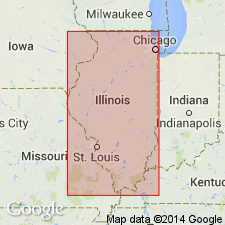
- Usage in publication:
-
- Seahorne limestone member
- Modifications:
-
- Overview
- AAPG geologic province:
-
- Illinois basin
Summary:
Pg. 165-167 (fig. P-2), 186. Seahorne Limestone Member of Spoon Formation of Kewanee Group. Name credited to Wanless, 1931, Illinois Geol. Survey Bull., no. 60, p. 191. Best known in western Illinois, where it varies from limestone nodules in claystone to a solid ledge of limestone more than 6 feet thick. It is usually light-gray. In some places it is conglomeratic or brecciated and consists of dark-gray fragments that contain abundant brachiopods embedded in a light-gray matrix that is dominated by a diverse gastropod fauna. Another fauna, SPIRORBIS and ostracodes, is found at places and is generally considered nonmarine. The Seahorne is not persistent but occurs at many places in Illinois and adjacent states. In northern and western Illinois, it is below Wiley Coal Member and above DeLong Coal Member, and in southwestern and southeastern Illinois it lies below Davis Coal Member and above Vergennes Sandstone Member (all in Spoon Formation). It is the caprock of the Tebo coal in Missouri (Wanless, 1957, Illinois Geol. Survey Bull., no. 82). Age is Middle Pennsylvanian (Desmoinesian).
Named from Seahorne Branch in Fulton Co., IL; type section consists of exposures along that stream, in S/2 SE/4 sec. 5, T. 3 N., R. 3 E. (Wanless, 1956, Illinois Geol. Survey Circ., no. 217, p. 9; Wanless, 1957, Illinois Geol. Survey Bull., no. 82, p. 76, 200).
Source: Publication.
For more information, please contact Nancy Stamm, Geologic Names Committee Secretary.
Asterisk (*) indicates published by U.S. Geological Survey authors.
"No current usage" (†) implies that a name has been abandoned or has fallen into disuse. Former usage and, if known, replacement name given in parentheses ( ).
Slash (/) indicates name conflicts with nomenclatural guidelines (CSN, 1933; ACSN, 1961, 1970; NACSN, 1983, 2005, 2021). May be explained within brackets ([ ]).

